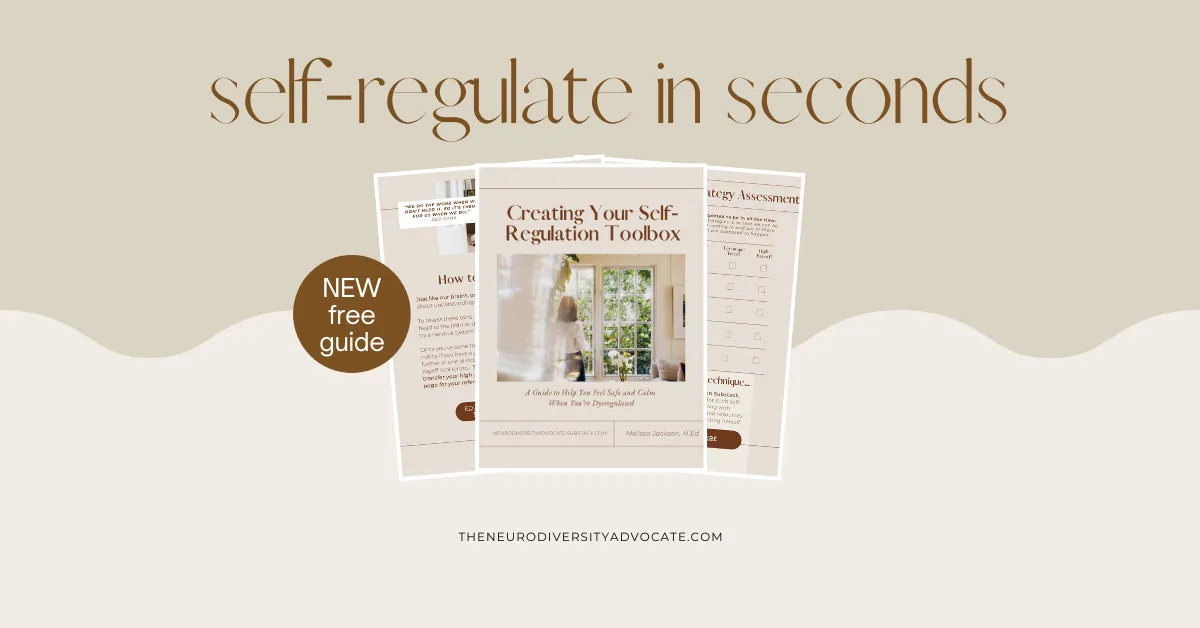Hey guys.
Today I want to talk through something I've personally struggled with my whole life: people pleasing.
As neurodivergent people, we so often talk about this idea of masking and how it's a coping mechanism so many of us unconsciously adopted in childhood
to feel safe
to feel loved
to feel accepted.
And many times it's not till we're much older that we realize we've created this false identity, or we don't have a real strong sense of self, because we've been people pleasing in order to fit in.
And it's not necessarily even a conscious choice. It's just something that sort of happens. These parts of us in our youth stepped in to protect us in this way. And then as adults we recognize that this isn't even me or this life doesn't fit.
It's almost like we're wearing a jacket that's too small.
And that’s when we decide we want to step into a more truthful, authentic way.
How do we stop people pleasing when it feels unsafe in our nervous system?
How do I show up as me when:
I'm not completely sure who me is?
And my nervous system is interpreting that idea as dangerous.
I just want to say this makes so much sense. And it's something that I personally have been moving through in my own life- so I absolutely get it.
The solution is the nervous system.
The solution is getting in touch with our bodies and our sensations.
Getting out of our minds and into our bodies to really feel into who we are.
How do I actually feel when someone asks me to do something?
What does a real yes or real no feel like in my body?
Letting go of the conditioning of who we were told to be.
And truly trusting those signals and following them and seeing where they lead.
This all comes back to understanding our nervous system and baby stepping our way up the nervous system ladder to feel safe with a new way, that's unfamiliar.
The Fawn State of the Nervous System
People pleasing, when we think about it in terms of the nervous system actually falls at the bottom of the nervous system ladder- in the fawn state.
Fawn is what we call a blended state:
It's a combination of flight and shutdown.
At the bottom of the ladder, is where we feel disconnected, shutdown, frozen, overwhelmed, or numb. We really dove into that in this post so you're going to want to start there for techniques when you’re feeling disconnected and need support thawing out and moving up the ladder.
Another state on the nervous system ladder is the blended state of fawn.
When we're in the state of fawn it is going to look like:
People pleasing
Pacifying or placating to avoid confrontation
Lack of boundaries and merging with other people and what they want and need from us
Abandoning ourselves and our own needs, desires, and boundaries.
And ultimately feeling responsible for the experiences of other people while ignoring our own needs.
Why do we people please?
This often happens when we grew up in environments where:
Anger was identified as “bad.”
Or we were punished for showing anger.
Maybe there was emotional disconnection in the house.
Or there was no model of healthy anger.
Maybe boundaries weren't modeled.
And so people pleasing became a way of staying safe. Of making sure that everyone around us was happy so no harm, judgment, criticism, or abandonment would be projected on us.
This can also come from codependent relationships because we have difficulty expressing our emotions.
And then we have trust issues.
And we're in this constant desire for approval in fear of conflict.
And we're trying to constantly control everyone's perception of us to think that we're nice and good because we're so afraid of:
Disappointing people.
Of people being mad at us.
Of people rejecting us.
Abandoning us.
Punishing us.
Whatever, negative association that was developed likely in our early childhood experiences.
But to make sure everyone around us is happy and their needs are met…. We lose touch with ourselves.
We lose touch with what actually matters to us. We learn to ignore the sensations within our own body, the signals within our nervous system, that are telling us that our boundaries have been crossed. That we don't like something. That we don't agree with something. That we don't want to do something.
And often this happens because we've internalized that that is mean or bad or wrong or dangerous to disagree with someone or to say no or to put ourselves first.
Learning to rewire your mind and feel safe in your body
So, for me, learning to rewire that thought process from an intellectual perspective, happened first.
Then on a bodily level, I would notice, even though I'd know intellectually that it was healthy and appropriate to say no to something that I didn't want to do. Or to disagree with someone in a respectful way, my body would have a physical reaction of going into fight or flight feeling like: “No, this is dangerous. This is unsafe.”
And so it's taken time to get my mind and what I understand intellectually to connect with the sensations I feel in my body to actually feel safe enough to set boundaries with not only people outside of myself but internally with the narrative I tell myself too.
The nervous system impacts our thoughts and our feelings, not the other way around.
So if we're in a state of fawn, we are going to:
Perceive everything as making us anxious.
Second guess ourselves.
Feel like we need to conform to please everyone around us because being ourselves is unsafe.
Hide who we are and what we truly think and feel because showing ourselves feels like a threat to our nervous system.
And what happens is then we suppress our natural fight response within us…
We disconnect from healthy anger and boundary setting because we perceive those things as threats to our safety.
It's a thwarted anger response:
We're holding anger inside.
We're not speaking up.
We're not saying how we truly feel.
That anger gets suppressed and turned inward.
And anger turned inward manifests as shame.
And so the antidote to shame… is healthy aggression.
Healthy aggression says: I am powerful. My voice deserves to be heard. It is safe to say no. I'm allowed to express how I feel. It is healthy to set a boundary.
We have to show our body that it's safe to do these things by:
Setting boundaries, externally and internally.
It's becoming the observer of our own thoughts and tuning in to which thoughts feel good in my body, which thoughts are actually true, and setting boundaries with the thoughts in our head.
Showing our nervous system that we are safe through titrated steps using specific self-regulation techniques.
4 Self-Regulation Strategies to Get You Out of the Fawn State
The nervous system responds to our feelings and sensations in the body. So thinking our way to being safe, doesn't work for the nervous system.
We've got to show our bodies the experience of being safe by baby stepping our nervous system into a new way.
Here are 4 techniques, specific to the fawn state, to help restore a healthy fight response and show your body healthy anger and boundary setting is ok:
The Towel Twist
In this technique, we think of a moment that recently made us irritated. While thinking of that moment we’ll breathe and twist the towel, allowing our muscles to tense.
This is a good way to release some of that adrenaline and cortisol that can be stuck in our body with a suppressed fight response.
Posture Rebound
The second one we're going to try today is called the posture rebound. With this technique, we’ll think about a time when you felt that a boundary was crossed or you were mad, annoyed, irritated and perhaps you didn't speak up. We’ll slowly collapse our body forward and roll up breathing and ending in a defense orientating posture or a fight posture.
Noticing if you feel a sense of power and feel a shift in your emotions.
The Pillow Squeeze
The third one we're going to do today is the pillow squeeze. Once you have your pillow, you’ll, again, think of a time when a boundary was crossed, when you felt annoyed, irritated, angry. Using that memory you’ll use one of two techniques to squeeze your pillow and tense your muscles.
The Hand Clasp
The fourth one we're going to try today is called the hand clasp. So again, we're tapping into a memory when we felt a boundary was crossed and we wished we would’ve spoken up. Then we'll hold our hands in a way to create tension and make our muscles tremble.
Afterward we’ll looks for signs that we’re releasing that stuck adrenaline and cortisol that grows when we have a thwarted anger response.
As always, I encourage you to find what feels good to your nervous system and feels like a high payoff for you. (my FREE toolbox tracker can help with that- get it here.)
So you can start creating a safe space to actually feel your anger, express it and metabolize it in a way that doesn't feel like too much. So that you can actually release the anger that is stuck in your body.
And that is empowering.
This is where we begin to love and accept ourselves. And we begin to shift that cycle of self-abandonment. And we start to have our own back. And we start to show up for those inner children who are so desperately wanting to be seen and loved and accepted by us.
This is such brave, hard work.
It sounds so simple. And so many of the things in the somatic world are quite simple. But at the same time, they are so hard.
So for those of you who are doing this alongside me, I see you. I appreciate you. I respect and acknowledge this hard work that you're doing because not everyone is doing this.
And yet, it’s the only way home to ourselves, to knowing ourselves, to finding safety in our own bodies, to seeing ourselves, to meeting those parts of us that just want to be seen and loved and acknowledged by us and to find safety in our bodies to unmask. This is how we get there.
If you have questions along the way or experiences you want to share, I really do want to hear from you and how this is landing.




























Share this post